#arsenit
Text










"Piil," Jägala Juga, Estonia,
Arsenit
#art#design#architecture#minimal#interior design#interiors#retreat#cabin#piil#estonia#jagala juga#arsenit#retrat#prefabricated#prefab#millwork#woodwork#woodworking#homedesign#homedecor
587 notes
·
View notes
Note
hi can i just say that i absolutely love all of the designs you gave allnthe iterators and their slugcats !! i especially love UI's scugs they r so pretty,,, may i ask for a few doodles of them. perhaps


Thanks alot!! Im glad you like my lil headcanons!!! *hands you doodles of the cats and their evil cat mom*
#totally not an excuse to draw ui again#hello ui u lil bastard#kimties :)#still struggling to draw cats but im trying jdjdjdj#rain world#gijinka#my art#unparalleled innocence#oc: the arsenil#oc: the arsenite#adding this is#nelly is based on a poison dart frog :)#nite is supposed to be the opposite color of nelly#not for any particular reason but for variety#nite is most definitely not the opposite of nelly#lyss art#travel puppet au#lore art
249 notes
·
View notes
Text

He angry
29 notes
·
View notes
Text

Crystal flop girlfaliure
#Her name is Arsenic but she prefers Arsenite or Nicky#…for obvious reasons#art#cartoon#biro#sketch#steven universe#steven universe oc#crystal gem oc#cartoon network#oc#original character
4 notes
·
View notes
Note
Hello! I love your blog bc it helps me a lot with writing and crafting. Thank you so much for making it!
Are there any patterns that deal with poison? Either in the pattern or in the dyeing process?
Even if there's not I'm glad you and this blog exist 💗
(anon continues) Poison in the dyeing process, like when green dresses were dyed with copper arsenite and it was extremely deadly.
Or a pattern of someone being poisoned, like a historical/folktale.
_______________________________________
Thank you for your kind words <3 I tried to keep things organized but the subject is huge so my of the top of my head answer is going in many directions. I hope you'll still find what you need :3
I'll briefly cover here dyes and (pigments), poison motifs, real life and supernatural poisonings. Buckle up we've got a long post ahead!
____ ABOUT DYE
Tbh I had to think for a moment because I don't recall major "poison" stories linked to dyes in Japan, be it fictionous or real (yet that doesn't mean none ever happened, especially considering Japan's history of industrial poisonings...).
Most gruesome details in the fabric industries I know of are about the horrific life & work conditions of female laborers in spinning mill manufactures (as in many countries, Japan industrialization process was ghastly...).
If potters and dyers had excellent practical knowledge, chemistry as a science officially started kind of late in Japan as it was not a local interest, and as rangaku (study of Western knowledge) often favored other subjects like medicine or warfare.
So, until the introduction of aniline dyes (not textile related, but this article about the use of synthetic dyes in ukiyoe printing is super interesting), Japanese worked with "natural" dyes, like ai (indigo) which was the most used during Edo period.
As with any ingredient, being natural doesn't equal safety. Some mixtures could be quite potent/foul, and process could be dangerous. Plants and minerals base ingredients could be toxic (cinnabar and orpiments were then used as paint pigments, and lead could be found in make up), as were mordants used to set colors.
If you want to easily overview which ingredients were used to create colors, I recommand browsing [Irocore] which presents colors with explanation in English in their database (pick a color then scroll down).
Not related to poison, but ai (indigo) is traditionally prepared in aigame/enormous floor set jars I find utterly terrifying:
I don't know if this tidbit can help you, but some dyes and mordants actually damage the fabric overtime, leaving them brittle (silk desintegrates after a while which is a huge issue in textile conservation).
____ POISON MOTIFS
Concerning "poison" themed patterns, none would be actually used traditionally on a kimono or an obi beside novelty items ^^;
For example, many plants can be toxic, but I don't see them set as pattern for this property - they'd rather refer to a poem, be a symbol of the passing of seasons etc. Fuji (wisteria) can be quite harmful, yet it's a beloved traditional motif in Japan.
You have much more chances to find pattern with kujaku (peacock) which are thought to be impervious to poison in Buddhism, than say venomous mukade (centipede) or the horrific ômukade (a youkai I covered in a folktale).
Snakes like the habu and mamushi are dangerous, but if used as pattern snakes are most often auspicious and linked to rain dragons or goddess Benzaiten.
If you squint hard, toxic fugu could count as poison pattern, but such a seasonal delicacy as a motif would mostly underline wealth (as those fishes are pretty expensive as they are prepared by specialized chefs), a kind of carpe diem spirit, or just a fun pattern because fugu balloon shape is cute ;)
____ POISON MURDERS
Poisoning was certainly a thing is Japan since ancient times (see kodoku sorcery). Poisons were for example used in some fishing techniques.
I am pretty sure some kuge and buke were disposed of this way - even thought poison was seen as a coward weapon (hence why its supposed to be only used by shinobi/ninja - even if this "fact" is opened to a lot of discussions!).
During Edo period, such murders made up the news and penny dreadful-like illustrated books favored by city dwellers in need of a fright. But those stories didn't pass to posterity beside cheap ukiyoe plates, and were never as popular as some shinjû (double suicides) or ghost revenges like poor poisoned and murdered Oiwa's:
____ SUPERNATURAL POISONINGS
If your poison is both physical and metaphorical illbeing, mushi could be your guys ^^ This term actually covers everything small and crawling, from real worms and insects, to anything inside one's body causing distress - be it a parasite, an unknown illness, an overboard emotion, a curse etc. If you've read/seen Mushishi you've got what I mean:
In fact any illness-causing being could count as poison-bringer. Hôsôkami (smallpox demon) was truly feared by all before vaccination was introduced in Japan.
Finally, continuing the supernatural poisoning trail, best girl is probably legendary fox witch Tamamo no Mae who among other terrible deeds made emperor Konoe fall sick with poisonous miasma (some version of the story attributes the disease to another monster, the nue). I covered a similar murderous kitsune folktale here.
#ask#japan#japanese history#dye#pattern#motif#poison#venomous#illness#natural dye#aniline dye#mordant#pigment#kujaku#peacock#mukade#centipede#omukade#youkai#snake#hebi#mamushi#habu#benzaiten#fugu#mushi#insect#mushishi#Hôsôkami#smallpox demon
109 notes
·
View notes
Text
Chrysiogenota
Group: Hydrobacteria; Proteobacteria
Gram-stain: Negative
Etymology: For Chrysiogenes arsenatis. From the Greek "chryseion", meaning "gold mine", and "genes", meaning "born from", because it was discovered in gold-mine wastewater.
About: Chrysiogenota are a phylum of obligate anaerobes, best known for the species Chrysiogenes arsenatis, who use arsenate as a final electron acceptor. This ability is extremely rare, given that arsenic is toxic to nearly all life. Since they thrive in arsenic-contaminated environments, C. arsenatis are considered extremophiles.
Sometimes, a bacteria being able to metabolize a harmful substance is a gift. But arsenate-reducing bacteria are dangerous: arsenate reduces to arsenite, which dissolves easily from mineral surfaces into water. This spreads arsenic through the ecosystem -- and to add insult to injury, the high solubility of arsenite makes it more readily absorbed into the body, and therefore more toxic. The activity of arsenate-reducing microbes causes widespread contamination of groundwater, harming both wildlife and humans.
Chrysiogenota bacteria may also use other electron acceptors, such as sulfur and nitrate, and the species Desulfurispirillum indicum can even use both selenate and selenite (which are selenium compounds). Selenium, like arsenic, is a toxic metal, and metabolizing it is a unique ability.
8 notes
·
View notes
Text
art by James W. Brown of JWB Mock Soup Company
text of label below the cut:
Campbell's Condensed Primordial Soup
QUICK & EASY DIRECTIONS
MIX SOUP + 1 OCEAN WATER
RADIATION: HEAT, UNCOVERED IN MICROWAVABLE OCEAN ON HIGH ABOUT 100 MILLION YEARS. CAREFULLY LEAVE IN OCEAN FOR 3 BILLION YEARS, ALLOWING OXYGEN TO ACCUMULATE.
SMOKER: HEAT, CIRCULATING OCCASIONALLY
PROMPTLY REFRIGERATE UNUSED PORTION ON A SEPARATE PLANET. RECOMMEND USE BY DATE ON END OF CAN.
STORE UNOPENED CAN IN INTERSTELLAR SPACE.
Nutrition Amount/serving Facts
Serv. Size 1 mole. serves one planet
Calories 0.0
Fat Calories 0.0
Serving size based on a 99% chance of a successful Origin of Life
Amount/serving %DV
Protein 0%
Fat 0%
Carbohydrate 0%
Fiber 0%
Vitamins 0%
L-amino acids 1%
D-amino acids 1%
Nucleic acid 0%
Metal sulfides 100%
Hydrogen 100%
Ammonia 100%
Methane 100%
Carbon monoxide 100%
Formaldehyde 100%
High MW PAHs 100%
NP-40 100%
Rich in reducing power, low in toxic oxygen and reactive oxygen products. High in heavy and transition metals. Great for the hottest, most radioactive watery planets.
Satisfaction guaranteed. For questions or comments please email [email protected]. Allow 5-6 x 10^24 years for refund or reply.
Save label: labels for evolution.
Please recycle carbon where enzymes available.
A QUICK MEAL IN 4.5 BILLION YEARS!
PRIMORDIAL SOUP: FOR THE PRIMITIVE...
AND THE PRIMITIVE AT HEART!
A SIMPLE, SELF-ORGANIZING MEAL WITH EVERYTHING YOU NEED TO GET YOUR LIFE STARTED BEFORE THE ARCHAEAN PASSES BY. GREAT FOR ALL WATERY PLANETS, SERVE HOT WITH LOTS OF REDUCING POWER AND A GOOD DOSE OF IONIZING RADIATION FOR THAT UNIQUE MICROBIAL FLAVOR!
INGREDIENTS: WATER, SILICA, IRON SULFIDE, HYDROGEN SULFIDE, CARBON DIOXIDE, HYDROGEN, POTASSIUM CYANIDE, POTASSIUM ACETATE, FORMALDEHYDE, ADENINE, PROLINE, ALANINE, METHANE, CARBON MONOXIDE, AMMONIA, SODIUM ARSENITE, GLYCEROL PHOSPHATE, ACETYLENE, ACETALDEHYDE, HIGH MOLECULAR-WEIGHT PAH'S, PYRENE, MAGNETITE, PHOSPHORIC ACID, WOLF'S TRACE MINERALS, AND NP-40.
JWB MOCK SOUP COMPANY, RALEIGH, NORTH CAROLINA [email protected]
#primordial soup#prebiotic earth#chemistry#biology#gillianthecat goes back to school#hw lb#i saved this image from my microbio lecture#couldn't find anything else about the artist online so if anyone has details please let me know#james w. brown#jwb mock soup company#1953 miller-urey experiment
9 notes
·
View notes
Text
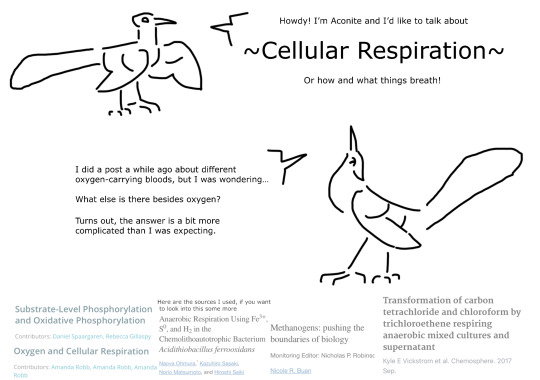

Image ID: Image IDS for the first two photos (an introduction and a summary of how respiration works in aerobic, anaerobic, and fermentation) can be found in the alt texts. ID for the chart is both here and in the alt.
In aerobic respiration, oxygen is breathed in in order to create ATP. Carbon dioxide is breathed out as a waste product. In fermentation, no single element is used to create ATP. Byproducts of this process include lactic acid, made by bacteria that turns milk into cheese curds and your muscles, ethanol, made by yeast and used in alcohol, butyric acid, made by bacteria in your gut and used in leather tanning, and vinegar.
There are a lot of examples of anaerobic respiration, mostly from bacteria. Respirating chloroform produces dichloromethane and carbon dioxide. Respirating chlorate produces chloride and oxygen. Sulfate produces hydrogen sulfide, and vinyl chloride produces ethene (also carbon, but the bacteria that does this uses the carbon so idk if it’s respirated). Nitrate and/or nitrogen dioxide produces ammonia and nitrite. Nitrite can then be further broken down into either nitrogen gas or nitrous oxide. Oxidized iron produces c-type cytochrome, which can the be oxidized back into oxidized iron. Arsenate produces arsenite, and selenate produces selenite, which can then be further reduced into red elemental selenium. And finally, acetone, coal, and several one-carbon compounds can produce methane gas. End image ID.
I mainly post this with speculative biology and worldbuilding in mind, which of course isn’t required to be entirely realistic. The setting I’m making right now sure ain’t. But it is probably worth saying that oxygen is still the most efficient, same way that hemoglobin is the most efficient. Also fermentation fucking sucks for producing energy everyone point and laugh.
#speculative biology#spec bio#speculative evolution#spec evo#little bird worldbuilding#worldbuilding#alien#scifi#xenobiology#my art#i guess?#this is a graph (biology)
8 notes
·
View notes
Text
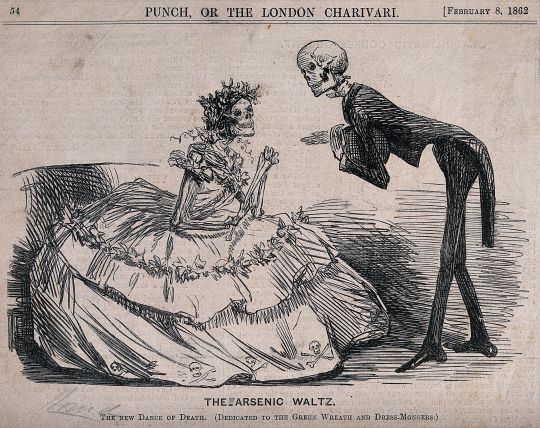
The Arsenic Waltz, 1862
A cartoon titled The Arsenic Waltz alludes to the use of arsenic in dresses and artificial flowers. The illustration appeared in Punch, a British humor magazine, a few months after a worker in the fashion industry died of arsenic poisoning.
On @jstor page we can read: The previous week, the chemist A.W. Hoffman had published an article 'The dance of death' in The times, 1 February 1862, in which he disseminated the finding that green dresses, wreaths, and artificial flowers, made with copper arsenite or coppper acetoarsenite (Scheele's green, Paris green), were toxic.
The British Medical Journal wrote that the arsenic-wearing woman carries in her skirts poison enough to slay the whole of the admirers she may meet with in half a dozen ball-rooms. In the mid-to-late 1800s, sensational claims like these began to turn public opinion against this deadly shade of green.
#spooky season#danse macabre#halloween#the arsenic waltz#arsenic#jstor#history#dance of death#gothique#skeleton#1860s#victorian#victorian era
5 notes
·
View notes
Note
fun fact, did you know that purple was originally named porphyra? and it was created by accident after trying to create a cure for malaria? OH! and also, green was originated from a bright green chemical named arsenite, and was named scheele's green!! i can't believe i found someone who also enjoys infodumping by the way. i'm so happy!! -andy 💚
Sometimes the best things are made by accident. I do enjoy hearing others infodumping about things they enjoy, especially if I get to learn something new in the process!
Though I do enjoy Porphyra as a name, maybe I should name something that. Possibly one of the shark plushies I've recieved.

#ask blog#ask the purple knight#rottmnt ask blogs#rise donnie#rise of the teenage mutant ninja turtles#rise of the tmnt#rottmnt#asks open
16 notes
·
View notes
Text

Skutterudite
Skutterudite is an arsenite containing variable quantities of Iron and Nickel.
This mineral occurs in Hydrothermal veins alongside Silver, Arsenpyrite, Nickeline, Quartz, Barite, Siderite, Calcite and Cobaltite.
Skutterudite gives off a strong garlic odor when heated or crushed.
1 note
·
View note
Text


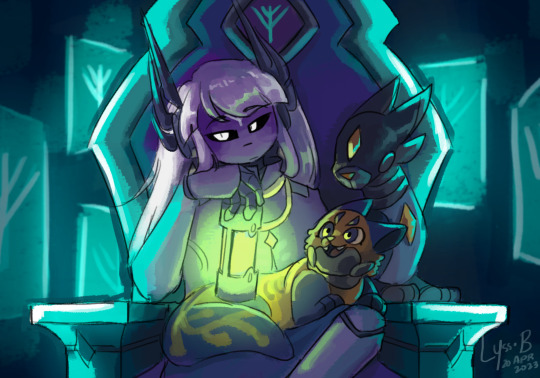

Okay MAYBE just one more System Failure art ft. UI concept art
I missed using krita so ive just been drawing on krita this entire day, it does help with the ask burn out
#my art#rain world#five pebbles#seven red suns#unparalleled innocence#gijinka#krita#whoever asked for suns reaction to pebbles i hope this counts cuz im chipping at the asks too lmao#fren said that double scythe pebbles should make a karma symbol and honestly big brain#ui and her arsenics :)#oc: the arsenil#oc: the arsenite#lyss art
364 notes
·
View notes
Text
Hej arseniter!
Nästa vecka, 17.2, har vi spelkväll på Portti! Välkomna!
2 notes
·
View notes
Text
Mapping #RNA-Protein Interactions with Subcellular Resolution Using Colocalization CLIP [Method]
RNA binding proteins (RBPs) are essential for RNA metabolism and profoundly impact health and disease. The subcellular organization of RBP interaction networks with target RNAs remains largely unexplored. Here, we develop colocalization CLIP, a method that combines CrossLinking and ImmunoPrecipitation (CLIP) with proximity labeling, to explore in-depth the subcellular RNA interactions of the RNA-binding protein HuR. Using this method, we uncover HuR's dynamic and location-specific interactions with RNA, revealing alterations in sequence preferences and interactions in the nucleus, cytosol, or stress granule compartments. We uncover HuR's unique binding preferences within stress granules during arsenite stress, illuminating intricate interactions that conventional methodologies cannot capture. Overall, coCLIP provides a powerful method for revealing RBP:RNA interactions based on localization and lays the foundation for an advanced understanding of RBP models that incorporate subcellular location as a critical determinant of their functions. http://rnajournal.cshlp.org/cgi/content/short/rna.079890.123v1?rss=1&utm_source=dlvr.it&utm_medium=tumblr
0 notes
Text
Çin'deki bir laboratuvarda ilk kez, gravitonun işaretleri keşfedildi

Çinli araştırmacıların önderlik ettiği uluslararası bir bilim insanı grubu, ilk kez , aynı zamanda yerçekimsel etkileşimin taşıyıcısı olarak da hizmet edebilen bir yerçekimsel alan kuantum - gravitonunun varlığının işaretlerini tespit edebildikleri bir deney gerçekleştirdi .
Graviton kavramı neredeyse 100 yıl önce oluşturuldu, ancak bilim adamlarının keşfine ancak şimdi yaklaşma şansı var.
Deneyin hazırlanmasına ve sonuçlarının analiz edilmesine Çin, ABD ve Almanya'dan bilim adamları katıldı. Kurulum üç yıl süren Nanjing Üniversitesi'nde oluşturuldu. Analiz edilecek malzemenin mutlak sıfıra yakın bir sıcaklığa soğutulması ve numunedeki elektronların uyarılmasını değerlendirmek için ince ayarlı bir lazere maruz bırakılması gerekiyordu. Aslında bunlar birbirini dışlayan gereksinimlerdir çünkü deney ortamı ile ölçüm cihazları arasında bir ısı köprüsü oluşur.
ABD'den elde edilen yüksek saflıkta galyum arsenit örneği -273,1 °C'ye soğutuldu ve Dünya'nın manyetik alanından altı kat daha güçlü bir manyetik alana yerleştirildi. Görev, atom kadar kalın bir malzemede, akışı sıvı gibi davranmaya başlayan yoğunlaştırılmış elektron durumunun etkisini yaratmaktı. Daha sonra bir lazer kullanılarak elektronların uyarılmış durumları değerlendirildi ve son olarak dönüşleri ölçüldü.
Bildiğiniz gibi elektronun spini tam sayı değildir ve 1/2'ye eşittir. Graviton'un spini 2 olmalıdır, bu da onu benzersiz kılar, eğer doğada mevcutsa. Deneysel verilerin analizi, bireysel parçacıkların 2'lik bir spin değeriyle karakterize edildiğini gösterdi. Bu kayıt dünyada ilk kez gerçekleştirildi.
Graviton keşfedilirse ve bu da hiçbir yükü olmayan kütlesiz bir parçacıksa, bu, birleşik alan teorisinin yaratılması için umut verecektir. Klasik fizik ile kuantum fiziği arasında hala tam bir bağlantı yoktur. Bu iki dünyayı birbirine bağlamaya izin vermeyen şey, yerçekimi etkileşiminin özünün anlaşılmamasıdır.
Read the full article
0 notes
Note
Hello! How about 🌸 and 🙃 for the ask game?
Hello! <3
🙃 What’s a weird fact that you know?
Scheele's Green was a vibrant pigment that was made of an arsenic compound (cupric hydrogen arsenite) that became really popular in the Victorian era. It was used to paint walls, dye clothes, used in children toys, etc. It was really toxic.
🌸 Best compliment you ever received?
I answered this in another ask and it was hard enough to think up one compliment I got, I can't think of another :')
1 note
·
View note